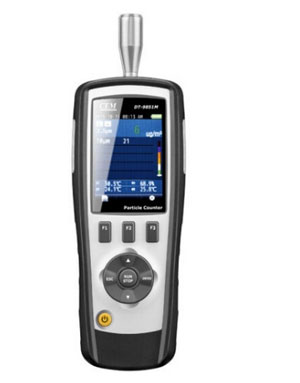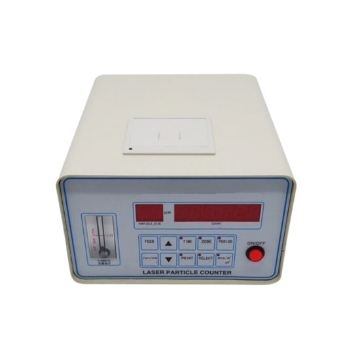Particle counters are instruments used to measure and count the number of particles in a given environment, such as air or liquids. These devices are widely used in various industries and applications to monitor and assess the cleanliness and quality of the air or fluids. Particle counters are critical tools in environments where the presence of particles can have a significant impact, such as in cleanrooms, healthcare facilities, pharmaceutical manufacturing, environmental monitoring, and research laboratories. In this paper, we will discuss how to choose a particle counter.
Operating principle
A particle counter is an instrument for counting dust particles by the scattering principle of light. Light scattering is related to particle size, wavelength of light wave, refractive index of particle, and absorption characteristic of particle. However, as far as the scattered light intensity and particle size are concerned, there is a basic law that the intensity of the scattered light by the particle increases with the increase of the surface area of the particle. In this way, a certain flow of dusty gas passes through a beam of strong light, so that the particles emit scattered light, which is projected to the photomultiplier through the condensing lens, and the light pulse is changed into an electric pulse, and the particle number is obtained from the pulse number. The diameter of the particle is obtained according to the function relationship between the intensity of the scattered light and the particle size. In this way, as long as the intensity of the scattered light is measured, the size of the particle can be deduced, which is the basic principle of the light scattering particle counter.
Factors
- Application and Environment:
Identify the specific application for which you need a particle counter. Is it for environmental monitoring, cleanroom validation, indoor air quality assessment, or something else?
Consider the environmental conditions where the particle counter will be used, such as temperature, humidity, and potential exposure to chemicals or harsh conditions. - Particle Type and Size Range:
Determine the types of particles you need to monitor (e.g., dust, allergens, bacteria, or sub-micron particles).
Specify the particle size range of interest, as different particle counters are optimized for various size ranges.  Sampling Method:
Sampling Method:
Decide on the sampling method, whether it's air or liquid sampling. Some particle counters are designed for both air and liquid applications, while others are specialized for one or the other.- Measurement Accuracy and Precision:
Review the specifications of the particle counter to ensure it meets your required accuracy and precision levels. - Data Output and Reporting:
Consider how you want to access and manage the data. Some particle counters offer data logging, data transfer options (e.g., USB, Wi-Fi, Ethernet), and reporting features. - Ease of Use and Portability:
Evaluate the user-friendliness of the device. Consider the size, weight, and portability of the particle counter, especially if you need to use it in different locations. - Calibration and Maintenance:
Determine the calibration requirements and ease of maintenance. Some particle counters may need more frequent calibration and maintenance, while others are designed for longer intervals between servicing. - Compliance and Standards:
Ensure that the particle counter complies with relevant industry standards and regulations. For example, ISO standards are often used in cleanroom environments. - Cost and Budget:
Establish a budget for the particle counter. Keep in mind that different features and capabilities can affect the price. - Brand and Reputation:
Consider the reputation and reliability of the manufacturer or brand. Established companies with a history of producing reliable instruments are often a safer choice. - Support and Service:
Check for the availability of customer support, technical assistance, and warranty options. Good support can be invaluable in case of issues or questions. - User Reviews and Recommendations:
Research user reviews and seek recommendations from others in your industry who have experience with similar applications. - Future Expansion:
Think about whether your needs might change in the future. Choosing a versatile particle counter that can adapt to evolving requirements is a wise strategy.
Key Features and Functions
- Particle Detection: Particle counters use various techniques to detect particles, including light scattering, light obscuration, and the Coulter principle. These methods involve measuring the interaction of particles with light or electrical fields to count and size particles.
- Particle Sizing: In addition to counting particles, particle counters can determine the size distribution of particles present in the sampled air or liquid. This information is often represented in the form of a particle size distribution graph.
- Particle Concentration: Particle counters measure the concentration of particles, typically expressed as the number of particles per unit volume (e.g., particles per cubic meter for air) or per unit area (e.g., particles per milliliter for liquids).
- Data Display and Reporting: The results of particle counting and sizing are typically displayed on the device's screen and may be recorded for documentation. Some models offer data logging and reporting features for further analysis and reporting.
- Sampling Methods: Particle counters can be used for either air or liquid sampling, and some models are versatile, allowing users to switch between different sampling methods.
- Calibration: To maintain accuracy, particle counters need periodic calibration to ensure that their measurements remain consistent and reliable.
The choice of a particle counter depends on the specific application, the type of particles being monitored, the desired particle size range, and other environmental conditions. Particle counters come in various sizes and levels of sophistication, from handheld devices for field measurements to larger, more specialized instruments designed for specific industries and controlled environments. The sisco storecan provide you with a choice of particle counters.

